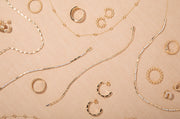"Imperfection is beauty, madness is genius and it's better to be absolutely ridiculous than absolutely boring."
- Marilyn Monroe
Although not directly referring to diamonds here, Marilyn did know a lot about the precious stones (Diamonds Are a Girl’s Best Friend, hello!) and was pretty spot on in her assessment of imperfection and beauty. Let’s discuss an important aspect of diamonds – their inclusions – and how these unique traces of imperfection make these beautiful gems extra unique. We’ll explore how diamond inclusions impact the appearance and value of a diamond and how lovely it is to embrace the flaws in things that are so naturally radiant.
Definition and Importance of Diamond Inclusions
A diamond inclusion is any internal flaw or imperfection found within a diamond. Like natural markers, diamond inclusions are crucial in grading processes as they affect the overall quality and carat. Inclusions can take many forms, such as small crystals, gas bubbles, or fractures, and they can vary in size, shape, and location within the diamond affecting its growth and form.
Inclusions are often used to help identify and grade diamonds, as they impact the clarity of the stone.
Typically, diamonds with fewer or less visible inclusions are more valuable.
However, inclusions can also add character to a diamond and, in some cases, make it more unique.
Common Types of Inclusions (e.g., Clouds, Crystals, Feathers)
Some common types of inclusions are:
-
Crystals: A small piece of another mineral embedded in the diamond.
-
Feathers: A crack or fracture within the diamond.
-
Clouds: A group of tiny inclusions that can appear as a hazy area within the stone.
-
Needles: A long, thin inclusion resembling a needle.
-
Chains: A small, shallow break along the edge of the diamond.
Why Inclusions Matter When Buying Diamonds
Diamond inclusions directly interfere with the diamond’s clarity, which is one of the key factors that influence the stone’s overall quality and value. Every diamond has its own unique set of inclusions, making it one-of-a-kind. Some people find the uniqueness of inclusions appealing, as it makes the diamond more personal.
However, durability can also be a concern, because feathers or cracks within the stone can create weak points, making the diamond more susceptible to damage, especially if it’s exposed to sharp impacts.
Internal vs. External Inclusions
Internal and external inclusions refer to the location of the imperfections within a diamond. Both types can alter the clarity, appearance, and value of the stone, but they have different characteristics.
Internal inclusions are located inside the diamond and are typically less visible to the naked eye. However, they typically have a more significant impact on the diamond’s clarity than external inclusions which are located on the surface of the diamond.
How Diamond Inclusions Affect Value
Diamond inclusions play a major role in determining a diamond's value, as they directly impact the clarity, appearance, durability, and overall desirability of the stone.
Diamonds with higher clarity grades (less inclusions) are more rare and valuable.
The type and location of the inclusion also factors into the diamond’s value.
For example, an inclusion near the diamond’s edge may be hidden by the ring setting and won’t change the stone’s value as much as an inclusion that’s very visible and close to the center of the stone.
Impact of Inclusions on Diamond Clarity
Inclusions disrupt the passage of light, reducing the diamond’s ability to reflect and refract light properly.
Dense inclusions, such as clouds, can also create a hazy or milky appearance and will therefore dull the diamond’s sparkle.
Feathers cause light to reflect differently which can make the diamond appear less clear.
How Inclusions Influence Diamond Pricing and Appearance
Typically, the clearer the diamond, the higher the price. So, a diamond with visible inclusions will likely be less expensive than one with fewer or no inclusions of the same size and color.
Diamonds that are graded “flawless” (no inclusions visible under 10x magnification) or “internally flawless” (no inclusions, but possibly some surface blemishes) are rare and highly prized, driving up their value.
However, not all inclusions significantly impact a diamond’s beauty. Certain features like surface flaws or knot formations can be less visible in specific settings. The key factors to consider are visibility, placement, and size of the inclusions. If chosen wisely, a slightly included diamond can still appear flawless to the naked eye while being more affordable.
How to Identify Diamond Inclusions
Professional gemologists use a 10x magnification loupe or a microscope to inspect inclusions.
A loupe is a small magnifying glass designed for jewelry inspection and is used to detect inclusions by holding the loupe close to your eye and bringing the diamond closer until it comes into focus. Once in focus, the diamond is rotated in order to inspect it from different angles by allowing bright white light or a diffused light source shine through the stone.
A microscope can provide an even closer look at tiny inclusions that may not be visible with a loupe.
The Diamond Clarity Scale and Its Role in Inclusions
Diamond clarity is a measure of how free a diamond is from inclusions (internal flaws) and blemishes (surface imperfections).
The GIA (Gemological Institute of America) developed the standard Clarity Scale, which helps buyers understand how inclusions impact a diamond’s quality, beauty, and value.
The clarity grades start at:
-
Flawless (FL): No imperfections
-
Internally flawless (IF): Very, very slightly included
-
VVS1, VVS2: Very slightly included
-
VS1, VS2: Slightly included
-
SI1, SI2: - I1, I2, I3: The inclusions are obvious to the naked eye.
The Diamond Clarity Scale helps buyers understand the role of inclusions in determining a diamond’s quality and value. While flawless diamonds are rare and expensive, many VS and SI diamonds appear just as beautiful to the naked eye and are much less expensive.
Inclusions near the edge of the diamond can be hidden by the ring’s prongs and therefore have minimal impact. Also, inclusions in brilliant cut diamonds (round, cushion, radiant, princess) can be hidden due to their many facets. These settings and cuts can help prevent the inclusions from impacting transparency and overall aesthetics.
How to Choose a Diamond with Inclusions
The key is to find a diamond where inclusions do not influence beauty, brilliance, or durability.
-
Look for an eye-clean diamond.
-
Pick a diamond with well-placed inclusions or choose a cut that masks imperfections.
-
Get a diamond with a GIA report that provides an objective clarity grade and a clarity plot showing the inclusions.
Hopefully you’re feeling well informed about diamond inclusions! We love discussing topics like this and more – please reach out to chat anytime! We believe in balance in all aspects of life and this holds true during the search for a dream diamond! We have seen how things (inclusions) that are considered “imperfect” have brought so much dimension and character to a stone that in turn brings balance to something that’s so purely stunning. Cheers to diamonds and beauty!





